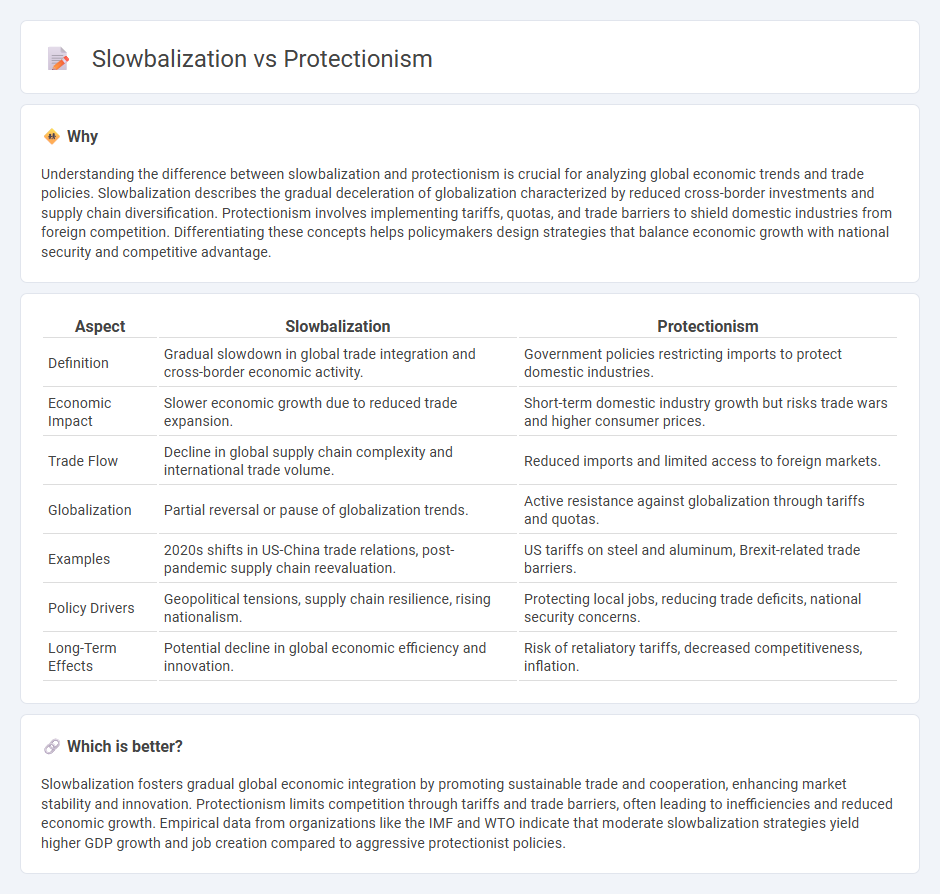
Slowbalization describes the gradual deceleration of globalization marked by reduced cross-border trade growth and complex supply chain restructuring, contrasting sharply with protectionism's emphasis on tariffs and trade barriers to shield domestic industries. The shift impacts global economic dynamics, altering investment flows, labor markets, and international cooperation frameworks. Explore how these competing trends reshape the future of global trade and economic policies.
Why it is important
Understanding the difference between slowbalization and protectionism is crucial for analyzing global economic trends and trade policies. Slowbalization describes the gradual deceleration of globalization characterized by reduced cross-border investments and supply chain diversification. Protectionism involves implementing tariffs, quotas, and trade barriers to shield domestic industries from foreign competition. Differentiating these concepts helps policymakers design strategies that balance economic growth with national security and competitive advantage.
Comparison Table
| Aspect | Slowbalization | Protectionism |
|---|---|---|
| Definition | Gradual slowdown in global trade integration and cross-border economic activity. | Government policies restricting imports to protect domestic industries. |
| Economic Impact | Slower economic growth due to reduced trade expansion. | Short-term domestic industry growth but risks trade wars and higher consumer prices. |
| Trade Flow | Decline in global supply chain complexity and international trade volume. | Reduced imports and limited access to foreign markets. |
| Globalization | Partial reversal or pause of globalization trends. | Active resistance against globalization through tariffs and quotas. |
| Examples | 2020s shifts in US-China trade relations, post-pandemic supply chain reevaluation. | US tariffs on steel and aluminum, Brexit-related trade barriers. |
| Policy Drivers | Geopolitical tensions, supply chain resilience, rising nationalism. | Protecting local jobs, reducing trade deficits, national security concerns. |
| Long-Term Effects | Potential decline in global economic efficiency and innovation. | Risk of retaliatory tariffs, decreased competitiveness, inflation. |
Which is better?
Slowbalization fosters gradual global economic integration by promoting sustainable trade and cooperation, enhancing market stability and innovation. Protectionism limits competition through tariffs and trade barriers, often leading to inefficiencies and reduced economic growth. Empirical data from organizations like the IMF and WTO indicate that moderate slowbalization strategies yield higher GDP growth and job creation compared to aggressive protectionist policies.
Connection
Slowbalization, characterized by reduced global trade growth and fragmented supply chains, is closely linked to protectionism, as nations implement tariffs and trade barriers to shield domestic industries. Protectionist policies exacerbate slowbalization by disrupting international market integration and increasing production costs. This cycle diminishes economic efficiency, leading to slower global economic expansion and altered investment patterns.
Key Terms
Tariffs
Tariffs serve as a primary tool in protectionism, aiming to shield domestic industries by increasing import costs and reducing foreign competition. Slowbalization, characterized by a gradual deceleration of globalization, impacts tariff policies as countries cautiously adjust trade barriers amid shifting economic priorities. Discover how evolving tariff strategies influence global trade dynamics and economic resilience.
Global supply chains
Protectionism disrupts global supply chains by imposing tariffs and trade barriers, leading to increased costs and delays in sourcing raw materials and components. Slowbalization, characterized by a gradual reduction in global interconnectedness, results in companies diversifying suppliers and shifting production closer to end markets to mitigate risks. Explore how these trends reshape international trade and supply chain strategies in the evolving economic landscape.
Trade barriers
Trade barriers such as tariffs, quotas, and import restrictions are central tools in protectionism, aimed at safeguarding domestic industries from foreign competition and preserving local jobs. Slowbalization reflects a global trend of reduced international trade growth and increased regulatory hurdles, with countries becoming more cautious about supply chain dependencies and emphasizing national economic security. Explore the implications of trade barriers on global markets and economic policies to understand the evolving landscape of international trade.
Source and External Links
Protectionism - Definition, Types, Advantages and ... - Protectionism is a trade policy where governments promote domestic producers by imposing tariffs, quotas, or subsidies to limit foreign goods, helping protect domestic industries and boost local production.
Implications of Trade Protectionism for the Economy - Protectionism involves government restrictions like tariffs and quotas to shield domestic industries from foreign competition, but may cause inefficiencies, higher prices, and retaliatory trade measures.
Protectionism - Wikipedia - Protectionism is the economic policy of restricting imports through tariffs, quotas, anti-dumping laws, subsidies, and administrative barriers to protect domestic producers and jobs from foreign competition.
 dowidth.com
dowidth.com